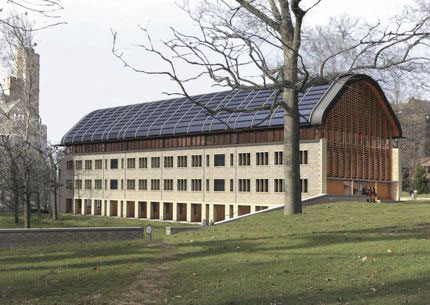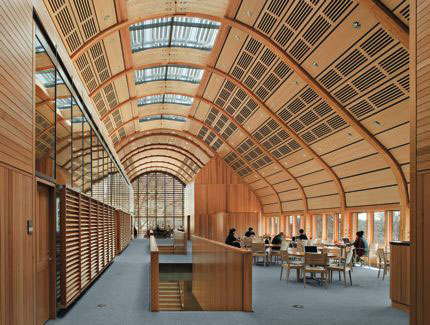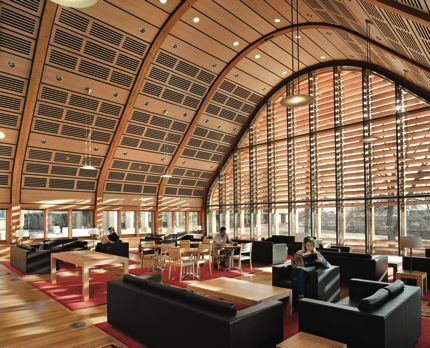
Exterior of Kroon Hall. Photo by Robert Benson
With its vaulted roof, communal spaces, and casual materials, the Yale School of Forestry & Environmental Studies’ new Kroon Hall feels more like an oversized house than its monumental appearance in photographs would suggest — albeit a house with ambitions. Its long volume, combined with the project’s hoped-for LEED Platinum status, evokes the great, sheltering form of an ark, one designed to float Yale into the 21st century, training the world’s future green leaders along the way.
Designed by London-based Hopkins Architects, with local firm Centerbrook Architects & Planners as executive architect, Kroon Hall is Yale’s fourth green building and, as befits the school’s curriculum, its most ambitious in sustainable terms, designed to use 50 percent less energy than a comparable modern building. Didactic features are few, but telling: Touch screens show the status of the building’s ground-source heat pumps, 100-kilowatt photovoltaic roof panel array, rainwater-recycling system, and solar hot-water heaters. Among other high-tech touches, red and green lights on each floor indicate when opening windows would be optimal, and a line of photovoltaics is showcased in clear glass over the central stair.

Interior of Kroon Hall. Photo by Robert Benson

Interior of Kroon Hall. Photo by Robert Benson
Despite these sustainable elements, the 58,200-square-foot building as a whole is low-key about its engineering. That sets it apart from most of the highly publicized green buildings of the last few years, particularly those with silvery skins and struts by British architects. There’s a hint of the 1970s ski lodge in the building’s wooden beams and abundant daylight. And Kroon Hall’s modest form is perhaps its most eco-friendly feature of all.
Hopkins’ paramount strategy from both a sustainable and an aesthetic perspective was to make Kroon Hall only 57 feet wide (and 218 feet long). That slimness makes it possible to daylight the entire interior during part of the year, as well as harness the building’s long south side for passive heating, and install operable windows. The result is that the visitor is always aware of the outer walls and the outdoors beyond them, usually glimpsed through layers of glass and oak louvers in a pleasantly constricting way.
That slim profile led to the rest of the structure’s form, with its open, column-free interior and a pitched roof that relates to the surrounding buildings without mimicking them. One adjacent roofline of note is the catenary curve of the Whale — Eero Saarinen’s 1956 Ingalls Rink — now undergoing thoughtful restoration and expansion across the street. Kroon Hall’s soft peak and indented sides suggest the influence of that modern icon on a traditional form, but Kroon’s rooftop PV panels, like oversize slate tiles, seem tame in comparison to the Whale’s swooping lines, and the roof seems a lost opportunity for Hopkins, however hard they were trying to fit in on campus.
Granted, they had another intimidating Yale precedent: Louis Kahn’s 1974 British Art Center, a major point of reference for British architects. What Kroon Hall has in common with Kahn’s masterpiece is simplicity and strength in materials: the oak, the exposed concrete walls and ceilings (the better to absorb and later radiate heat), the clear unfussy form. The building innovates in its entrance facades: three stories of glass shaded by fixed louvers made of Douglas fir. Openness and practicality, homely wood and shiny glazing — it’s the pairing of those elements that give Kroon Hall its interest.

Interior of Kroon Hall. Photo by Robert Benson
It is where Kroon diverges from the simplicity of Kahn that I have my biggest problem with the design, aside from the lingering sentimentality in that roofline. The south and north facades are faced in sandstone, bright enough to make you squint on a sunny day. The sandstone, its texture rough and ugly, appears nowhere inside the building, and so stands out as alien.
Already, students and faculty have embraced the building as their own, and the top floor (really a top deck) is a hub of chance meetings and chats. The suggested nickname for the Knobloch Environment Center, the Knob, has given rise to a movement to call the adjacent, smaller cafe area the Bloch. In a sign of messy vitality, a competition has already been held to combat the lack of cleanliness of the communal kitchen. Meanwhile, faculty members have overruled the red lights and opened the windows on non-optimal days, deeming the lights unduly authoritarian.
But there’s also a certain blandness about the interiors. All that red oak paneling (50 percent from Yale’s own forests) is beautiful, but a little monotonous. The high-ceilinged Knob, furnished with red rectangles of carpet and dark brown sofas, feels like an ecclesiastical hotel lobby. Dean Gus Speth, whose tenure spanned the inception, construction, and completion of Kroon Hall, reportedly imagined that space as a boisterous, freethinking commons, and has been disappointed that it is the quietest of the public areas. More socializing is getting done in the ground-floor lounge: Its low ceilings and carpeted floor suggest a rec room, and behavior follows.
Kroon Hall is a model of comfortable, even beautiful, sustainable architecture, neither institutional nor fussy, informal in a truly modern way. I can’t put it in the first rank of Yale’s modern architectural wonders, as nothing about it is technically or architecturally stunning. But few buildings can run with that crowd, and several of those (Paul Rudolph’s Art and Architecture Building, Eero Saarinen’s Morse & Stiles Colleges) were less accommodating to student life from the start. Kroon’s greatest strength may be that it feels designed precisely for student life, with lots of room to make one’s mark.
